Earthship Biotecture Transcribed: Session 2/ Part6: Black Water Treatment In Any Climate, Food Production.
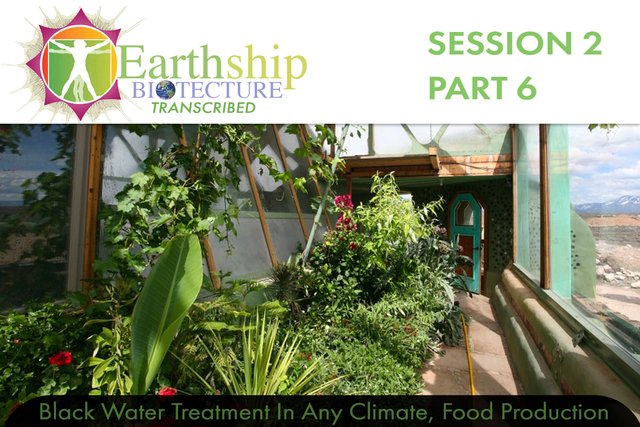
I would like to thank Mike Reynolds for giving me permission to transcribe, edit and reformat this work for the Steem Blockchain! If you do read or watch this and have any questions please ask in the comments. I am happy to educate and help you to understand this. Biotecture is amazing in so many ways, and even after 20 years I still have not seen a model of sustainable building that even comes close in so many important areas such as performance, carbon footprint, longevity, ease of build, etc... Now you can also come to understand what Biotecture Really Is about!
Commentary
How do you get approval for black water treatment? How do you treat black water safely in wet climates? Can you really have an oasis around your home, even in the desert? This post is all about Black Water, that is the water from your toilets. There is a lot of water used in to flush toilets, but that is OK with earthship biotecture since you use second had grey water to flush with, and then irrigate them outdoors (potentially covered in wet climates). If you pass this black water through enough reed beds, you can then pass it through a final food production planter and grow healthy safe food year round and in any part of the world.
You can learn about what approach is best suited to your climate, and use this information to help you plan your design. My advice is to always cover an outdoor botanical cell, because you never know when the climate will change.. and having protected food production is a very good idea wherever you are!
Earthship Seminar Transcription Session 2 - Part 6:
So anyway that's the nature of the the gray water system, and so what what we do then is... if you take a regular plumbing wall, and you know you've got the washing machine and dryer, and then you got the bathtub, and you got the sink, you got the toilet... you got the kitchen sink... well we take the kitchen sink and the toilet and we take them straight out... and say this is the front of the house ... we take the kitchen sink of the toilet, we take them straight out to a conventional septic tank and that septic tank goes into an outdoor botanical cell... which you can see it the Sutton job. That's enough to treat the water right there because you're taking half of the water and treating it inside with the gray water system... more than half. So your washing machine, your bathtub, your lavatory, they all go to the Botanical cells inside the building and inside the greenhouse... however many of them you have.
No water is lost in this Earthship
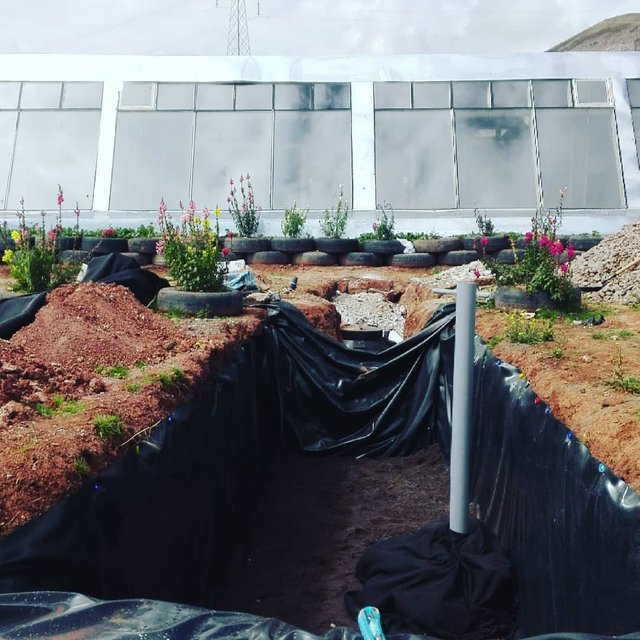
IMAGE SOURCE .
Getting Approval For Water Treatment... Fake it!
What we do to to fool the authorities is as this gray water goes into the Botanical cell, we have a three-way valve here that can allow it to go into the Botanical cell, or let it bypass on and go right back to the black water. So really what we have in place at any given time, is a conventional system... every piece of plumbing, every fixture... if you turn the three-way valve, goes to the septic tank. That's what they want to see, that's their worm pill and abala hamburger. Well you've got a conventional system... and I showed it this way to the authorities, I actually have a I think it's in the water from the sky book. I have a letter from the main authority, who's now dead... of the state of New Mexico... and he said, "you have a conventional system inherently in your system, you don't even need a variance... because the even the black water botanical cell, they don't count it." We go out of it and put in a conventional drain field, they only cost six or eight hundred dollars... and they'd never gets used because all the stuff goes into the septic tank, and we turn the three-way valve so that all the grey water goes into the botanical cells, and at the end of the line of the botanical cells you suck the water back to flush the toilet with.
So you're using the same water, so what happens in the septic tank is we size it as if it were a normal septic tank... but it's only using half the volume, and then half the volume can easily be treated in something like a 14ft by 40 ft botanical cell, which is laying open out there at Sutton so you can see it... and the septic tank is going right into it. But to keep them happy, this is just disregarded by them, we call it pretreatment and some of them appreciate it, but they don't consider it... so what we have when we turn the three-way valve for everything to go in the septic tank, it just runs through this, they ignore it, and they have a septic tank and a drain field... and if it's in the city it we take it through the septic tank and on into the municipal sewage.
So we have given the authorities a conventional system so they don't have to fret over approving of ours and the reason for that is because state officials don't make that much money, they're not being paid to take risks on people's ideas... even though they may be, you know headed toward carbon 0 and whatever. They just have to go by the book, so we let them go by the book. So then what really happens outside is it's another botanical cell, the septic tank serves as the grease and particle filter.
Use Black Water to Create An Outdoor Lush Oasis... Even in the desert!
Suitable for dry climates
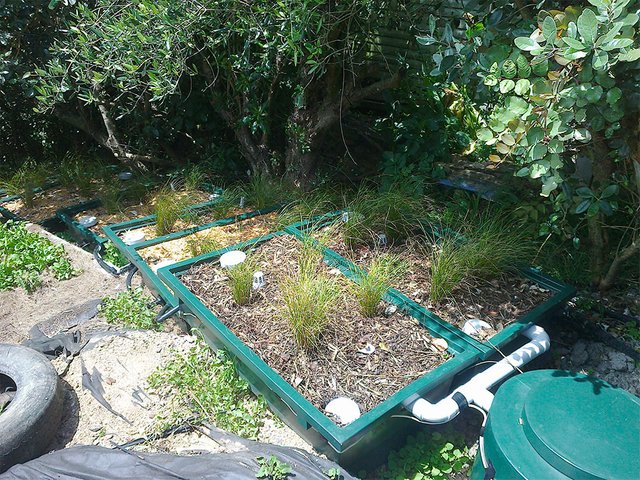
One of the questions that often comes up in relation to Earthships is why do they use flush toilets instead of composting toilets. The design for the Waiheke earthship intends to follow the Earthship approach to sewage treatment and recycle used water (grey water) through interior plant filters/ botanical cells which is then used for flushing toilets and then treated using a Simple Wastewater Solutions vermi-composting wastewater system. This wastewater system is an advancement over a standard septic tank as all the toilet wastewater goes into an exterior solid waste digestor where the worms turn it to compost. Instead of having to pump out a septic tank every few years (and send the sludge to landfill), the end result is nutrient rich compost which can be used in the orchard. The Simple Wastewater Solutions system also involves a series of exterior plant filters which further treats the wastewater by filtering it and transforming it to an aerobic state by using natural processes instead of electric air pumps which most conventional onsite waste water treatment systems require.
SPOURCE
If you don't know it what goes on in a septic tank is an anaerobic process where bacteria is broken, down solids are broken down into a liquid. The liquid goes into the botanical cell... the botanical cell is full of plants, and they oxygenate the water and use the water. And we have gotten the size down to where there's nothing that comes out. The drain field is worthless, but we put it in to make them happy... and then what that does is we spread these botanical cells out, and make them shallower and strategically located... so that the building then has all these green spots happening around it... from the botanical cells. There's your landscaping, there's your water for your outdoor plants.
And you can see that... on the newer ones it's hard to see it, because it's not happening yet. But some of the older ones, which I don't know if Kirsten's taking you to, you really see lush lush green in contrast to the dry parched Mesa and that's the nature of an Earthship... it brings green. No water that ever falls from the sky on your property ever goes away from your house. It's just going into plants and whatever.
Growing Food Successfully in Northern Europe and Freezing Climates
So that's the that's the sewage system to take that into different climates. The experiment we did at the Phoenix is the the outdoor Botanical cells. We just ended up building a greenhouse over them, so that we can illustrate how this can work in a severe northern cold climate. You know, the the green is not going to be that impressive our functional if it's 40 below zero for six months. So it's just not going to work that well. So if you build a greenhouse over it, all of a sudden you have a whole lot more food production, and a whole lot more sewage treatment, and another buffer zone... and on and on and on. And more water catchment because you got more roof.
How to you produce safe food using black water
The Phoenix is illustrating that the Phoenix is entire system is enclosed and you you can grow food. If you grow food out of the black water, test it. We always test the food, we take it to a testing agency and you get it tested. What we we do is we'll test an artichoke out of our system, and we'll test an artichoke from the health food store. And if they test similar then then that's good enough. There are things on line we're gonna get this out and documented, that tell you what items are most easy to produce out of even black water, other than you know, other than just landscaping... I'd be satisfied with this just that.
But you can break your black water into a series of cells in other words you have one cell than another cell than another cell the best one to eat out of is the last one... because it's gone through the cells before it and oxygenated. I mean I wouldn't eat out of the very first black water cell out of the septic tank without super testing it. But we've we've done a lot of different tests and it's always been good.
Of course the grey water is fine. You can produce a lot of food by salvaging every drop of water that you have. So nothing ever leaves. And then, like I say, you you can do this completely outside in a temperate climate. You don't even have to have greenhouses for it, but but there's all kinds of little idiosyncrasies.
Botanical Cell Sewage Treatment in Wet / Cold Areas
What if you're in a area, like where we're going in Texas, that gets over fourty inches of rain a month? What would happen there is your outdoor black water cell would get saturated with rain. So what we have to do in situations like that is one, sometimes we have to put a greenhouse over it for that reason... not to protect it from the cold, but protect it from the rain... because the water for it comes from the sewage itself. In not quite as bad of a situation, we'll put it out in front... and slope the surface of it... and we catch the water off the front face and take it in...to flush with. And even on the highway landscaping they have these membranes that just have holes for the plants to come out, and the water then runs off of it.
So you can you can fill this with your sewage water to water your plants and get the sky water to go away from it, there so there are a lot of different applications of this, relative to your temperature and your length of winter, and your level of rainfall.
Different conditions make it so you may have to protect or greenhouse over it. Here in this climate we don't get enough rain to mess with it at. all. All it does is stash some of the rain as well. One other aspect of this which I just mentioned, you can see it at the Sutton house best. We catch all the water off the roof of the house and dump it into the cisterns like I was saying. But the front face catches a little water, and it's too low to go into the cistern. So we put a gutter at the bottom of the front face, run the gutter around and dump it into the botanical cells. They get washed out with rainwater... and even stashed up with rainwater, and they're all set. The botanical cells at the end of the line have an overflow that goes to the septic tank anyway. And then the septic tank runs to an outdoor botanical cell, and then if that ever overflowed it overflows into conventional drain fields.
Earthship Sewage Treatment
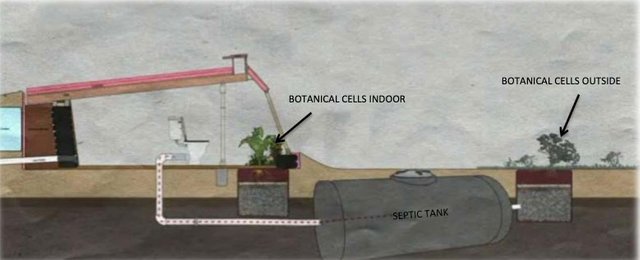
Black water from the toilet is flushed into a septic tank where the solid waste is broken down to liquid through an anaerobic process.
Thereafter, the water is sent to the outdoor botanical cells or an outer greenhouse.
These cells are designed to have completely absorbed the water by the time it reaches the last cell.

Earthship Seminar Video 2009 - Session 2 -Part 6

READ PREVIOUS TRANSCRIPTS
SESSION 1
Part 1: The Global Model
https://steemit.com/ecotrain/@eco-alex/earthship-biotecture-101-learn-with-michael-reynolds-part-1
Part 2: Staying Cool: The Convection Engine
https://steempeak.com/ecotrain/@eco-alex/earthship-biotecture-transcribed-seminar-with-michael-reynolds-transcribed-part-2
Part 3: The Evolution of the Global Model Earthship:
https://steempeak.com/ecotrain/@eco-alex/earthship-biotecture-transcribed-seminar-with-michael-reynolds-part-3
Part 4: Heating your home with body heat in Norway, about permits in USA and Europe... How to get them fast
https://steempeak.com/ecotrain/@eco-alex/earthship-biotecture-transcribed-pt4-heating-your-home-with-body-heat-in-norway-about-permits-in-usa-and-europe-how-to-get-them
Part 5: How to Retrofit, Getting Permits, Tire Toxicity?
https://steempeak.com/ecotrain/@eco-alex/earthship-biotecture-transcribed-pt-5-how-to-retrofit-getting-permits-tire-toxicity
Part 6: Bottle / Can Walls, Tyre Foundations / Snow Water
https://steempeak.com/ecotrain/@eco-alex/earthship-biotecture-transcribed-pt-6-q-and-a-bottle-can-walls-tyre-foundations-snow-water
Part 7:&: Can you insure an earthship?, the double/triple greenhouse, the global model evolution + more
https://steempeak.com/ecotrain/@eco-alex/earthship-biotecture-transcribed-pt-7-q-and-a-can-you-insure-an-earthship-the-double-triple-greenhouse-the-global-model
Part 8: Final: Year round fruiting trees, sizing greenhouses + more
https://steempeak.com/ecotrain/@eco-alex/earthship-biotecture-transcribed-pt-8-final-q-and-a-year-round-fruiting-trees-sizing-greenhouses-more
SESSION 2
Part 1: Water, how to size your roof, choosing the right materials for water catchment.
https://steempeak.com/ecotrain/@eco-alex/earthship-biotecture-transcribed-session-2-part-1-water-how-to-size-your-roof-choosing-the-right-materials-for-water-catchment
Part 2: Cisterns, Filtering Water, Designing Down & Layered Thinking.
https://steempeak.com/ecotrain/@eco-alex/earthship-biotecture-transcribed-session-2-part-2-cisterns-filtering-water-designing-down-and-layered-thinking
Part 3: Water! Be Self Sufficient Secure & Sustainable.
https://steempeak.com/ecotrain/@eco-alex/earthship-biotecture-transcribed-session-2-part-3-water-be-self-sufficient-secure-and-sustainable
Part 4: Botanical Cells, Using Water 4 Times, Food Production.
https://steempeak.com/ecotrain/@eco-alex/earthship-biotecture-transcribed-session-2-part-4-botanical-cells-using-water-4-times-food-production
Part 5 : The Solar Toilet, Making Mistakes and Evolving is Part of the Process.
https://steempeak.com/ecotrain/@eco-alex/earthship-biotecture-transcribed-session-2-part-5-the-solar-toilet-making-mistakes-and-evolving-is-part-of-the-process

Did you know, I built four Earthships in India as well as being instrumental the creation of the first Earthship in the UK, Earthship Brighton. If you are also on this path and would like to read my story, I have recently published a book. It is not only a great story, but a valuable resource for you to learn from. I had no experience or training when I embarked on my mission, but managed to successfully build a gorgeous home called Earthship Karuna.
You can buy this book with Steem on the homesteaders co-op. Whilst you are there please do have a look at some of the other products as there are all kinds of great things there!

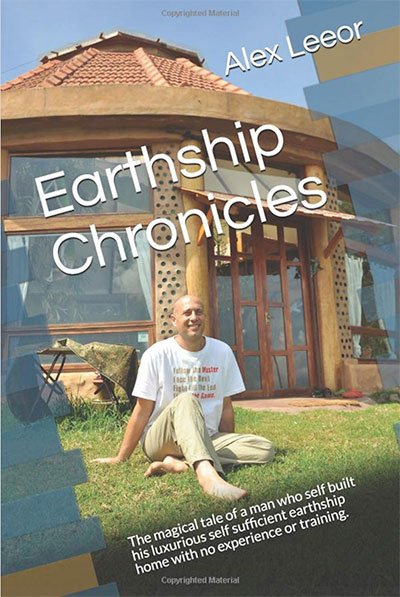
https://homesteaderscoop.com/product/earthship-chronicles-ebook/
If you don't have any Steem you can also buy the ebook and paperback on amazon.
http://mybook.to/Earthship-Chronicles
or
https://www.amazon.com/Earthship-Chronicles-sufficient-luxurious-experience-ebook/dp/B07MYCBXYB
@ecoTrain
Supporting People Who Help
Make The World A Better Place

Discover previous ecoTrain magazines at @ecoTrain
** Click Here To View Our Passenger Feed**

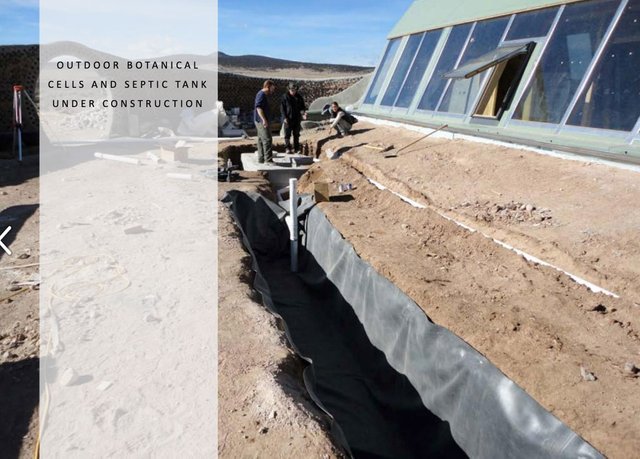

I appreciate the images and diagrams SO MUCH in this series! Helps make it real and imaginable and something I can wrap my head around. My 83 year old mother expressed interest in reading about Earthships, after I talked about it with her today. So I'm sending her the links - amazing to see the growth and change in her! Much gratitude for your diligent self in posting this material. Game changer!
Leading the curation trail for both @ecotrain & @eco-alex.
Together We’re Making This World A Better Place.
Click Here To Join the manually curated trail "@artemislives" to support quality eco-green content.
@ecoTrain
Thank u! Your grandma!!’ Wowwwweeeeee what a woman, u must have a leaf out of her book...!
It's getting a little difficult for me to understand the process but I am getting the point. In the middle east this system can help to a great extend to increase the green areas in every locality with the system.
im SURE it is difficult to understand!.. ITs only really when you are starting to think about actually building that any of this really becomes interesting, or useful. The whole approach really turns everthing on its head, and so yes in the middle east there would be many benefits over a normal home.
Natural Climate control would be one of the biggest game changers.. most people are reliant on unhealthy dry air conditioning systems. These systems are HUGE power drains, and cost a lot to run.. Earthships use natural convection and cool air underground using buried air pipes to bring a naturally cool breeze into every room with zero power use or any moving parts, no bills, and its proper healthy air!
I never thought on these lines, but yes it would be so good to have a natural cooling system. But I do not think the systems will want to implement because it would be a big hit on some of the conventional businesses.